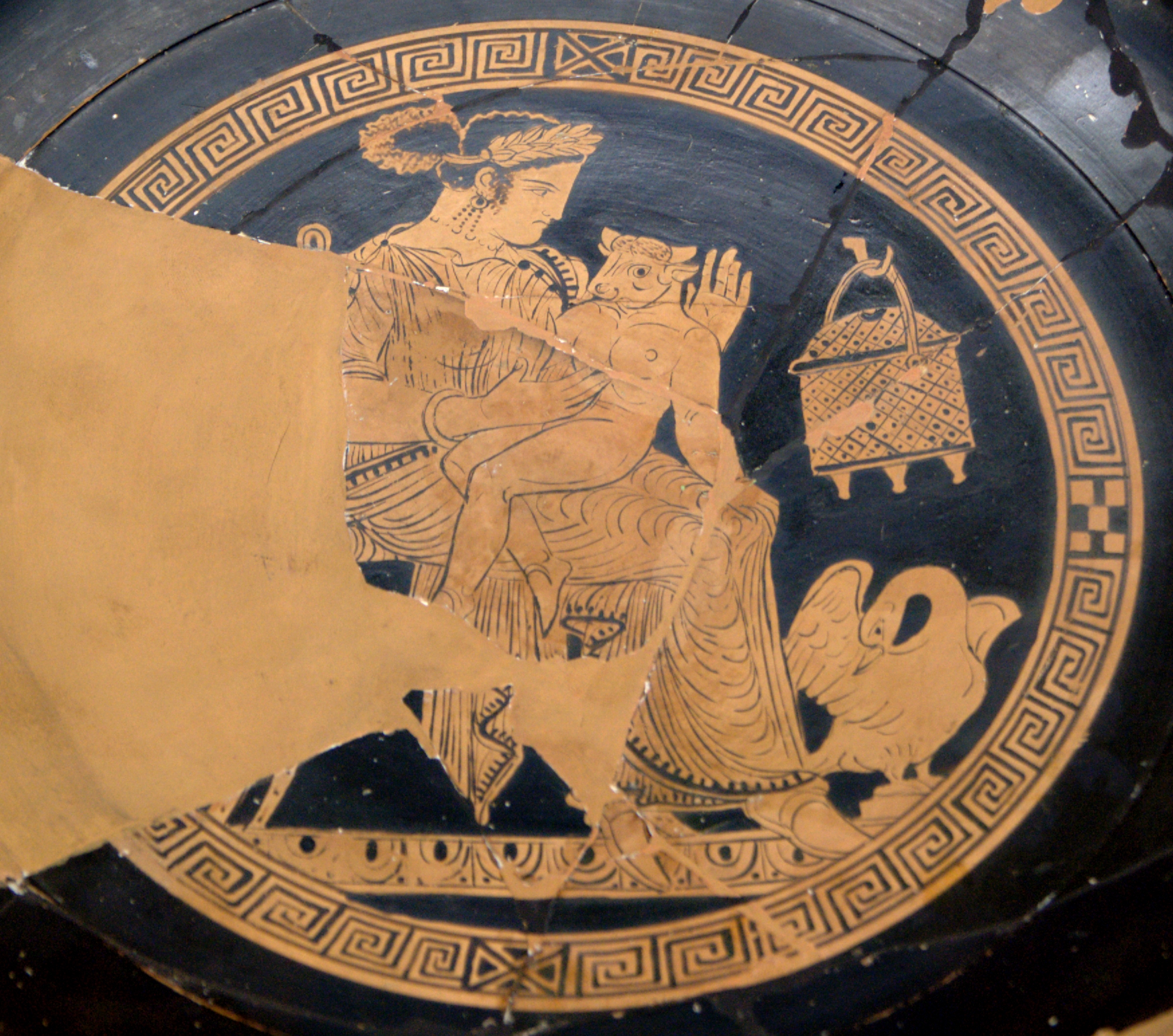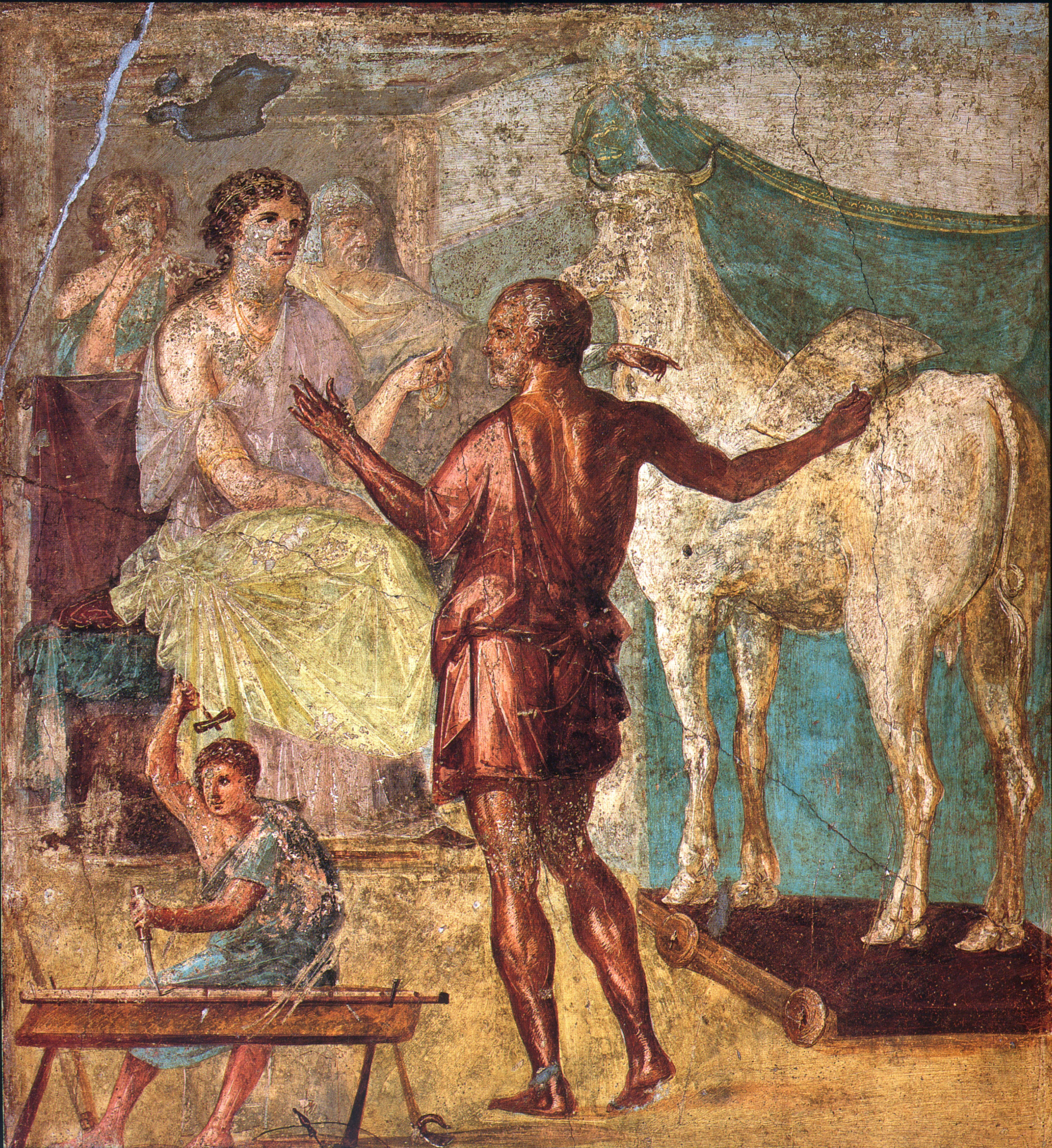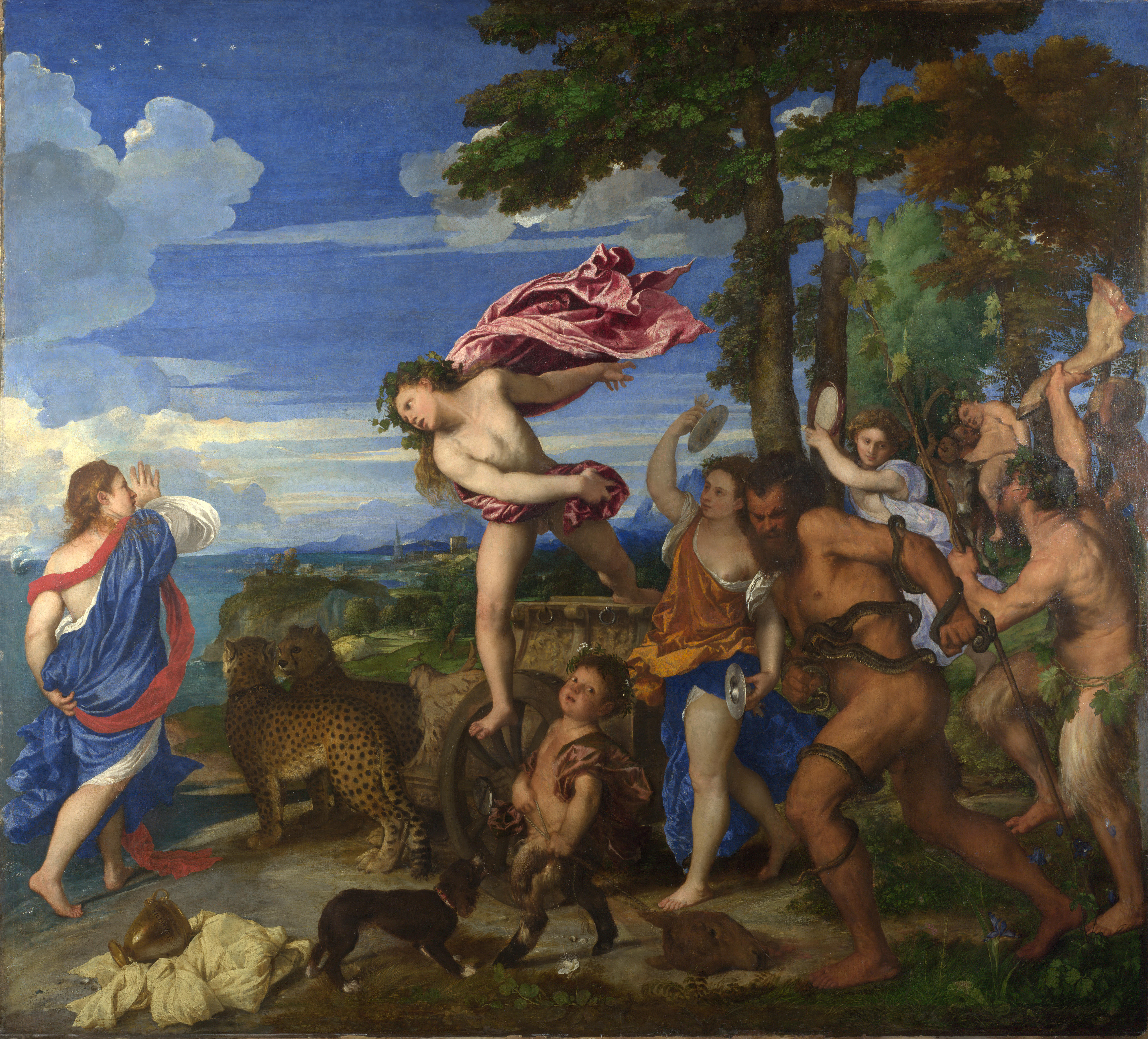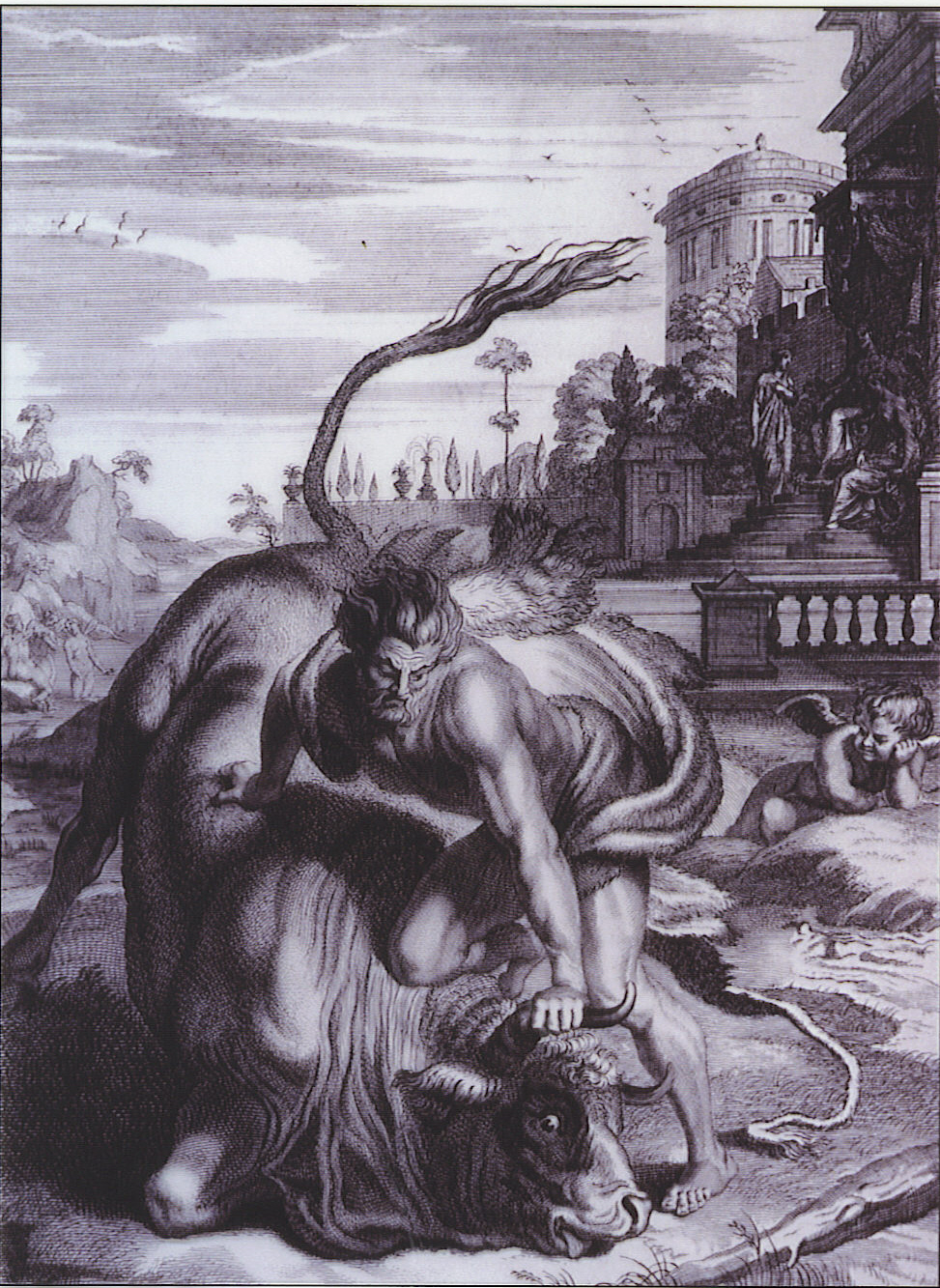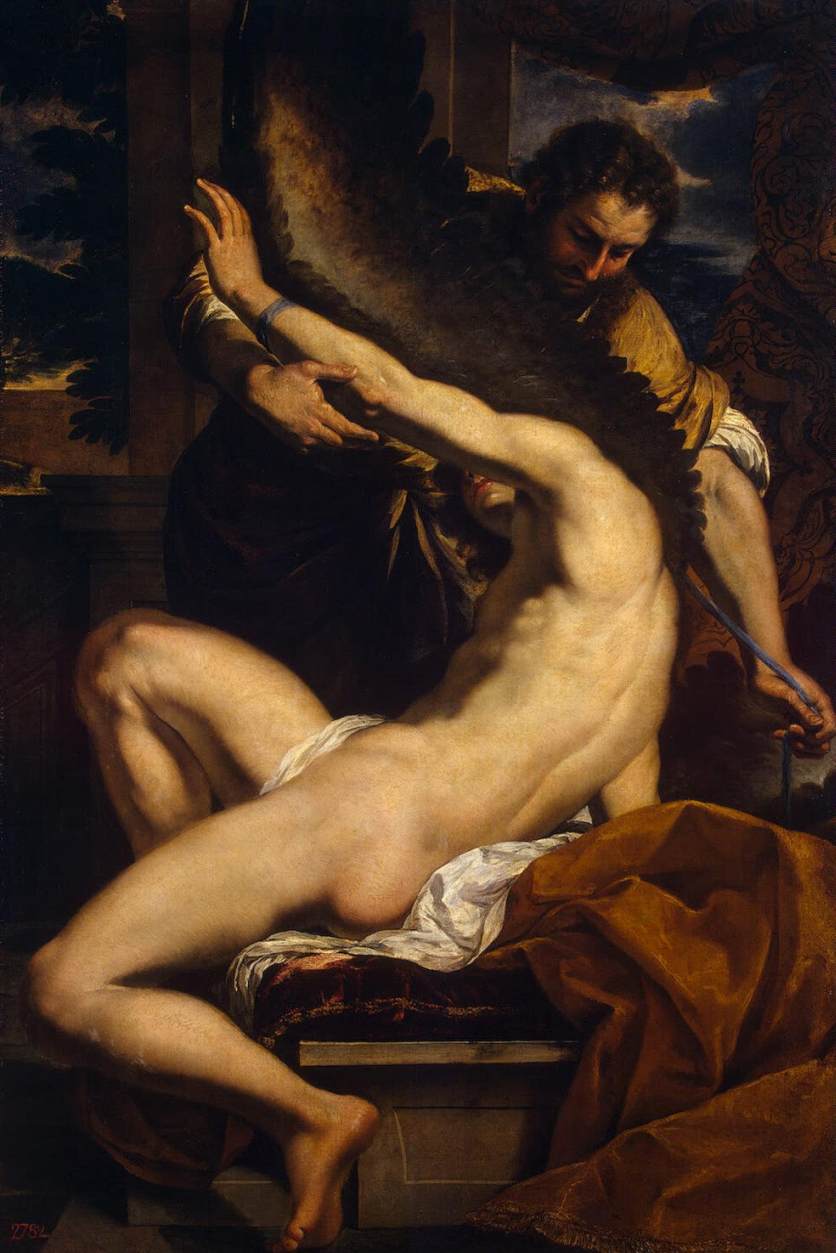|
Minotaur
In Greek mythology, the Minotaur (, ''Mīnṓtauros''), also known as Asterion, is a mythical creature portrayed during classical antiquity with the head and tail of a bull and the body of a man or, as described by Roman poet Ovid, a being "part man and part bull". He dwelt at the center of the Labyrinth, which was an elaborate maze-like construction designed by the architect Daedalus and his son Icarus, upon command of King Minos of Crete. According to tradition, every nine years the people of Athens were compelled by King Minos to choose Sacrificial victims of the Minotaur, fourteen young noble citizens (seven men and seven women) to be offered as sacrificial victims to the Minotaur in retribution for the death of Minos's son Androgeus (son of Minos), Androgeos. The Minotaur was eventually slain by the Athenian hero Theseus, who managed to navigate the labyrinth with the help of a thread offered to him by the King's daughter, Ariadne. Etymology The word "Minotaur" derives from ... [...More Info...] [...Related Items...] OR: [Wikipedia] [Google] [Baidu] |
Theseus
Theseus (, ; ) was a divine hero in Greek mythology, famous for slaying the Minotaur. The myths surrounding Theseus, his journeys, exploits, and friends, have provided material for storytelling throughout the ages. Theseus is sometimes described as the son of Aegeus, king of Athens, and sometimes as the son of the god Poseidon. He is raised by his mother, Aethra (mother of Theseus), Aethra, and upon discovering his connection to Aegeus, travels overland to Athens, having many adventures on the way. When he reaches Athens, he finds that Aegeus is married to Medea (formerly wife of Jason), who plots against him. The most famous legend about Theseus is his slaying of the Minotaur, half man and half bull. He then goes on to unite Attica under Athenian rule: the ''synoikismos'' ('dwelling together'). As the unifying king, he is credited with building a palace on the fortress of the Acropolis. Pausanias (geographer), Pausanias reports that after ''synoikismos'', Theseus establishe ... [...More Info...] [...Related Items...] OR: [Wikipedia] [Google] [Baidu] |
Pasiphaë
In Greek mythology, Pasiphaë (; , derived from πᾶσι (dative plural) "for all" and φάος/φῶς ''phaos/phos'' "light") was a queen of Crete. The daughter of Helios and the Oceanid nymph Perse (mythology), Perse, Pasiphaë is notable as the mother of the Minotaur. Her husband, Minos, failed to sacrifice the Cretan Bull to Poseidon as he had promised. Poseidon then cursed Pasiphaë to fall in love with the bull. Athens, Athenian inventor Daedalus built a hollow cow for her to hide in so she could mate with the bull, which resulted in her conceiving the Minotaur. Family Parentage Pasiphaë was the daughter of List of solar deities, god of the Sun, Helios,Antoninus Liberalis41/ref> and the Oceanid nymph Perse (mythology), Perse. She was thus the sister of Aeëtes, Circe and Perses of Colchis. In some accounts, Pasiphaë's mother was identified as the island-nymph Crete (mythology), Crete herself. Like her doublet Europa (consort of Zeus), Europa, the consort of Zeus, h ... [...More Info...] [...Related Items...] OR: [Wikipedia] [Google] [Baidu] |
Ariadne
In Greek mythology, Ariadne (; ; ) was a Cretan princess, the daughter of King Minos of Crete. There are variations of Ariadne's myth, but she is known for helping Theseus escape from the Minotaur and being abandoned by him on the island of Naxos. There, Dionysus saw Ariadne sleeping, fell in love with her, and later married her. Many versions of the myth recount Dionysus throwing Ariadne's jeweled crown into the sky to create a constellation, the Corona Borealis. Ariadne is associated with mazes and labyrinths because of her involvement in the myths of Theseus and the Minotaur. There are also festivals held in Cyprus and Naxos in Ariadne's honor. Etymology Greek lexicographers in the Hellenistic period claimed that ''Ariadne'' is derived from the ancient Cretan dialectical elements ''ari'' (ἀρι-) "most" (which is an intensive prefix) and ''adnós'' (ἀδνός) "holy". Conversely, Stylianos Alexiou has argued that despite the belief being that Ariadne's name is of ... [...More Info...] [...Related Items...] OR: [Wikipedia] [Google] [Baidu] |
Labyrinth
In Greek mythology, the Labyrinth () is an elaborate, confusing structure designed and built by the legendary artificer Daedalus for King Minos of Crete at Knossos. Its function was to hold the Minotaur, the monster eventually killed by the hero Theseus. Daedalus had so cunningly made the Labyrinth that he could barely escape it after he built it. Although early Cretan coins occasionally exhibit branching (multicursal) patterns, the single-path (unicursal) seven-course "Classical" design without branching or dead ends became associated with the Labyrinth on coins as early as 430 BC, and similar non-branching patterns became widely used as visual representations of the Labyrinth – even though both logic and literary descriptions make it clear that the Minotaur was trapped in a complex branching maze. Even as the designs became more elaborate, visual depictions of the mythological Labyrinth from the Roman era until the Renaissance are almost invariably unicursal. Branching maz ... [...More Info...] [...Related Items...] OR: [Wikipedia] [Google] [Baidu] |
Cretan Bull
In Greek mythology, the Cretan Bull () was the bull Pasiphaë fell in love with, giving birth to the Minotaur. Mythology Background Minos was king in Minoan civilization, Crete. In order to confirm his right to rule, rather than any of his brothers, he prayed Poseidon send him a snow-white bull as a sign. Poseidon sent Minos the bull, with the understanding that the bull would be sacrificed to the god. Deciding that Poseidon's bull was too fine of a specimen to kill, Minos sent the bull to his herds and substituted another, inferior bull for sacrifice. Enraged, Poseidon had Aphrodite curse Pasiphaë, the wife of Minos, causing her to fall in love with the bull. She subsequently gave birth to the half-man, half-bull, Minotaur. Poseidon passed on his rage to the bull, causing him to lay waste to the land. After consulting the oracle at Delphi, Minos had Daedalus construct the Labyrinth to hold the Minotaur. The seventh labour of Heracles Heracles was sent to capture the bull ... [...More Info...] [...Related Items...] OR: [Wikipedia] [Google] [Baidu] |
Daedalus
In Greek mythology, Daedalus (, ; Greek language, Greek: Δαίδαλος; Latin language, Latin: ''Daedalus''; Etruscan language, Etruscan: ''Taitale'') was a skillful architect and craftsman, seen as a symbol of wisdom, knowledge and power. He is the father of Icarus, the uncle of Perdix (mythology), Perdix, and possibly also the father of Iapyx. Among his most famous creations are the wooden cow for Pasiphaë, the Labyrinth for King Minos of Crete which imprisoned the Minotaur, and wings that he and his son Icarus used to attempt to escape Crete. It was during this escape that Icarus did not heed his father's warnings and flew too close to the sun; the wax holding his wings together melted and Icarus fell to his death. Epigraphic evidence The name ''Daidalos'' seems to be attested in Linear B, a writing system used to record Mycenaean Greek. The name appears in the form ''da-da-re-jo-de'', possibly referring to a sanctuary. Family Daedalus's parentage was supplied as a later ... [...More Info...] [...Related Items...] OR: [Wikipedia] [Google] [Baidu] |
Sacrificial Victims Of The Minotaur
In Greek mythology, the people of Athens were at one point compelled by King Minos of Crete to choose fourteen young noble citizens (seven young men and seven young women) to be offered as sacrificial victims to the half-human, half-taurine monster Minotaur to be killed in retribution for the death of Minos' son Androgeos. Mythology The victims were drawn by lots, were required to go unarmed, and would end up either being consumed by the Minotaur or getting lost and perishing in the Labyrinth, the maze-like structure where the Minotaur was kept. The offerings were to take place every one, seven or nine years and lasted until Theseus volunteered to join the third group of the would-be victims, killed the monster, and led his companions safely out of the Labyrinth. Plutarch in his ''Life of Theseus'' cites a rationalized version of this myth, referring to Philochorus who in his turn claimed to be following a local Cretan tradition. According to it, the young people were not actually ... [...More Info...] [...Related Items...] OR: [Wikipedia] [Google] [Baidu] |
Icarus
In Greek mythology, Icarus (; , ) was the son of the master craftsman Daedalus, the architect of the labyrinth of Crete. After Theseus, king of Athens and enemy of King Minos, escaped from the labyrinth, Minos suspected that Icarus and Daedalus had revealed the labyrinth's secrets and imprisoned them—either in a large tower overlooking the ocean or in the labyrinth itself, depending upon the account. Icarus and Daedalus escaped using wings Daedalus constructed from birds’ molted feathers, threads from blankets, the leather straps from their sandals, and beeswax. Before escaping, Daedalus warned Icarus not to fly too low or the water would soak the feathers and not to fly too close to the sun or the heat would melt the wax. Icarus ignored Daedalus's instructions to not to fly too close to the sun, causing the beeswax in his wings to melt. Icarus fell from the sky, plunged into the sea, and drowned. The myth gave rise to the idiom, "wikt:fly too close to the sun, fly too close ... [...More Info...] [...Related Items...] OR: [Wikipedia] [Google] [Baidu] |
Phaedra (mythology)
In Greek mythology, Phaedra (; ) was a Crete, Cretan princess. Her name derives from the Greek word (), which means "bright." According to legend, she was the daughter of Minos and Pasiphaë, and the wife of Theseus. Later in life, Phaedra fell in love with her Stepchild, stepson, Hippolytus of Athens, Hippolytus. After he rejected her advances, she accused him of trying to rape her. In response, Theseus prayed to Poseidon and asked the god to kill Hippolytus, which he did. Phaedra then committed suicide. The story of Phaedra is told in Euripides' play ''Hippolytus (play), Hippolytus'', Seneca the Younger's ''Phaedra (Seneca), Phaedra'', and Ovid's ''Heroides''. It has inspired many modern works of art and literature, including Phèdre, a play by Jean Racine. Family Phaedra was a daughter of King Minos and Queen Pasiphaë of Crete, who had a total of eight children together. This included three daughters: Acacallis (mythology), Acacallis, Ariadne, and Xenodice (mythology), Xen ... [...More Info...] [...Related Items...] OR: [Wikipedia] [Google] [Baidu] |
Greek Mythology
Greek mythology is the body of myths originally told by the Ancient Greece, ancient Greeks, and a genre of ancient Greek folklore, today absorbed alongside Roman mythology into the broader designation of classical mythology. These stories concern the ancient Greek religion's view of the Cosmogony, origin and Cosmology#Metaphysical cosmology, nature of the world; the lives and activities of List of Greek deities, deities, Greek hero cult, heroes, and List of Greek mythological creatures, mythological creatures; and the origins and significance of the ancient Greeks' cult (religious practice), cult and ritual practices. Modern scholars study the myths to shed light on the religious and political institutions of ancient Greece, and to better understand the nature of mythmaking itself. The Greek myths were initially propagated in an oral tradition, oral-poetic tradition most likely by Minoan civilization, Minoan and Mycenaean Greece, Mycenaean singers starting in the 18th century&n ... [...More Info...] [...Related Items...] OR: [Wikipedia] [Google] [Baidu] |
Androgeus (son Of Minos)
{{Other uses, Androgeos In Greek mythology, Androgeus or Androgeos (Ancient Greek: Ἀνδρόγεως, Latin: ''Androgeum'' or ''Androgeōs'' derived from ''andros'' "of a man" and ''geos'', genitive ''gē'' "earth, land") was a Cretan prince as the son of King Minos. Family Androgeus' mother was Pasiphaë, daughter of Helios. Apollodorus, 3.15.7 He was the brother of Acacallis, Ariadne, Deucalion, Phaedra, Glaucus, Catreus and Xenodice. Androgeus' sons were Sthenelus and Alcaeus, who later became companions of Heracles. Mythology Androgeus was murdered in Athens. Sources vary as to the exact circumstances of his death. Some stated that Androgeus participated in the Panathenaic Games and took all the prizes, whereupon he directed to Thebes to take part in another contest in honor of Laius, but was ambushed and killed by his envious would-be competitors. Servius suggests that Androgeus was murdered upon his triumph by the Athenians themselves and the Megarians. ... [...More Info...] [...Related Items...] OR: [Wikipedia] [Google] [Baidu] |
Crete
Crete ( ; , Modern Greek, Modern: , Ancient Greek, Ancient: ) is the largest and most populous of the Greek islands, the List of islands by area, 88th largest island in the world and the List of islands in the Mediterranean#By area, fifth largest island in the Mediterranean Sea, after Sicily, Sardinia, Cyprus, and Corsica. Crete is located about south of the Peloponnese, and about southwest of Anatolia. Crete has an area of and a coastline of 1,046 km (650 mi). It bounds the southern border of the Aegean Sea, with the Sea of Crete (or North Cretan Sea) to the north and the Libyan Sea (or South Cretan Sea) to the south. Crete covers 260 km from west to east but is narrow from north to south, spanning three longitudes but only half a latitude. Crete and a number of islands and islets that surround it constitute the Region of Crete (), which is the southernmost of the 13 Modern regions of Greece, top-level administrative units of Greece, and the fifth most popu ... [...More Info...] [...Related Items...] OR: [Wikipedia] [Google] [Baidu] |
